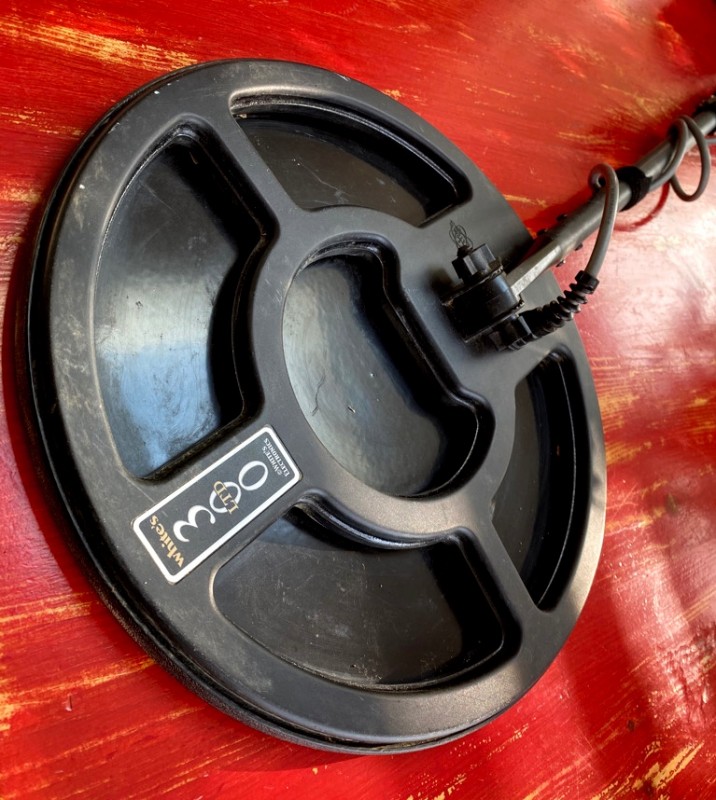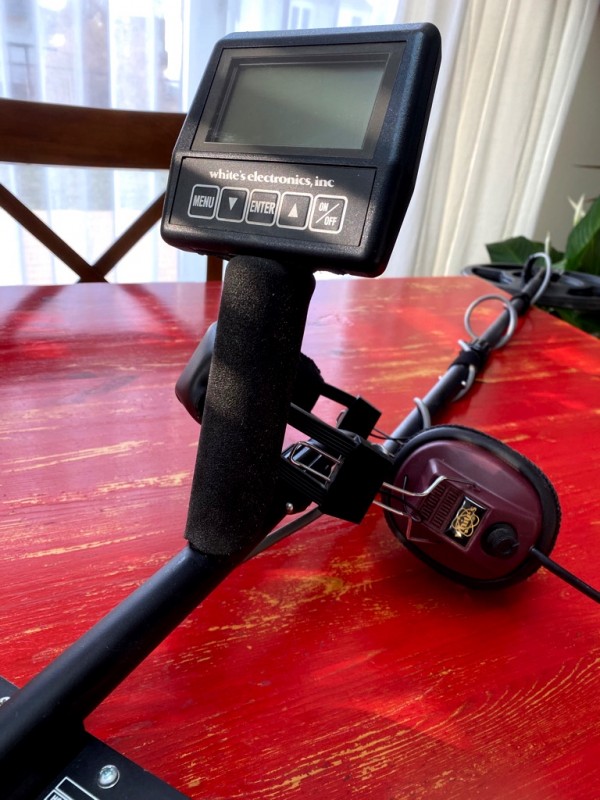Search the Community
Showing results for tags 'dfx vx3 v3i'.
-
John in Florida here. My Whites DFX Spectra V3 won't turn on. I need to see if I can get a new circuit board. Any ideas?
-
-
I am a big fan of the White's SignaGraph display. A version 1.0 was originally developed for the Eagle Spectrum. The Eagle Spectrum underwent a complete hardware revamp, and was renamed the Spectrum XLT. A more refined version 1.1 of the software was matched up in the XLT with a much better LCD display. The SignaGraph was also used on the DFX, and was largely the same as on the XLT, with the addition of multifrequency options. The SignaGraph was later greatly enhanced on the V models (Vision, V3, V3i, VX3) and renamed the SpectraGraph. The genius of the SignaGraph/SpectraGraph is the ability to display multiple target id numbers at the same time, and even to choose how the target id number is determined. Here is the SignaGraph explained by its designer, engineer Mark Rowan. More details can be gleaned from the White's XLT User Guide. Spectrum XLT Engineering Note The SignaGraph™ "Phase Spectrum Analyzer" by Mark Rowan Some time ago, I had a conversation with an avid treasure hunter whose instrument of choice was White's Eagle II SL 90. He described to me a technique with which he could discern pull tabs from rings, nickels, and other desirable targets by listening for some subtlety in the audio response. Then he asked me, "If I can do this, why can't you program the Eagle's microprocessor to do it?" My response was, "If you can do it yourself, why would you want the microprocessor to do it for you?" I mention this as a means of illustrating what I consider to be the metal detector designer's fundamental dilemma, which is, as Prince Hamlet might have phrased it, "To beep or not to beep". More specifically, if you're faced with a target at some depth in badly mineralized ground and the detector has a hard time getting a solid reading on it, what do you do? If you design your detector to ignore the target, and then someone comes along with their El Cheapo brand detector and digs the target, which just happens to be a $10 gold piece -- you're in big trouble. If, on the other hand, your customers find that they're spending most of their time chiseling through eight inches of hardpan and finding bent nails and wads of aluminum foil, you're not much better off. The point I was trying to make with the gentleman who had devised the clever pull tab discriminating scheme was, that if you put too much of that kind of "intelligence" into your metal detector, there are always going to be those targets that you miss because the machine got fooled. Which brings me, of course, to the newest White's model, the Spectrum XLT. The Spectrum XLT has all of the features, performance, and flexibility of previous members of the Eagle series, plus a new display which makes the instrument remarkably easy to use. It also makes use of a new way of displaying information about targets -- the "SignaGraph™ or "Phase Spectrum Analyzer" -- which shows the operator everything that we currently know how to display about the characteristics of metallic objects in the ground. In this way, we have gone a long way towards addressing the dilemma I mentioned earlier. The Spectrum XLT is a very "smart" detector, but it is also an "honest" one. Having done the best it can to determine the probable identity of a target, the Spectrum XLT gives you all of the information you need to make your own decision (human beings are, despite what you might have heard, still a whole lot smarter than computers) to dig, or not to dig. Before I begin to describe in some detail what the SignaGraph™ is and how it works, I should emphasize that you don't need to know how it works in order to use it effectively, and that the best way to learn how to use it.... is in the field. In a very short time you will begin to recognize certain display patterns as being characteristic of certain types of targets. I should also point out that even if you ignore the SignaGraph™ altogether, this instrument still has the audio discriminator, V.D.I. number, that its predecessors had, plus the icons, and some significant improvements in terms of weight, physical size, and ease of operation. White's SignaGraph display For many years, White's has built detectors which identify targets based on a V.D.I. number (V.D.I. stands for Visual Discrimination Indicator) which characterizes metallic objects according to their size, shape, and composition. The V.D.I. scale on the Spectrum XLT runs from -95 to +95. Large positive numbers typically indicate objects which are good electrical conductors; for example, silver dollars will come in at 92. Smaller positive numbers usually indicate objects which, because of their size, shape, or composition, are not as conductive; nickels will read about 20 and aluminum foil may come in near 5. Large negative numbers are typical of targets which are readily magnetized, but which conduct electricity poorly or not at all. Some sands or soils which have a high concentration of ferromagnetic minerals may read -93. Metals containing iron have both magnetic and conductive properties, which causes them to spread over a wide area of the scale, although most typically iron objects will fall in the range -30 to -75. The V.D.I. reading is an excellent way to determine the identity of most commonly occurring targets, although I might mention in passing that the only 100% reliable discriminator is called a shovel. However, as a famous metal detector engineer once said, "Life is grossly unfair" (actually, there is no such thing as a famous metal detector engineer, and life really is fair, it just doesn't want anybody to know). For one thing, the signal which a detector receives back from even moderately mineralized ground is typically much stronger than the signal it receives from the targets buried in it. This makes determining an accurate V.D.I. number for a target at any substantial depth a very challenging business indeed. Furthermore, some targets will cause an abrupt change in V.D.I. response during the course of a single pass under the loop; the most notorious of these are the dreaded bottlecap and the dreaded small piece of foil near the surface in bad ground. Enter, as they say, the Spectrum XLT. The SignaGraph™ is very similar in some respects to the familiar analog V.D.I. meter. The display is calibrated from left to right in V.D.I. units, from -95 to +95. When the loop is passed over a target, a V.D.I. determination is made, and a vertical bar is placed at the appropriate place on the scale; near the right end of the scale, say, for a reading of 78. So far, this is just what an analog V.D.I. meter would do. At this point, the similarity ends. An analog meter can indicate only one value at a time; with the SignaGraph™, up to 30 readings can be displayed simultaneously. Also, the vertical height of the bars in the display has significance; the height can either be used to indicate signal strength or a running total of the number of readings at that point on the scale ( the operator may choose which of these two indications is to be used). The advantage of this type of display format becomes evident when the loop is passed over a bottlecap or some other flat, thin iron object. Although the instrument may respond with a loud, clear audio output, and the V.D.I. readout may register a value near the upper end, the SignaGraph™ will tend to "smear out"; numerous segments will appear throughout the display, many or most of them in the negative (typically iron) range. Try the same things with a coin, and you won't see the "smear"; typically you will see 1-3 bars grouped closely together near the top end of the scale. If any smearing does occur, as it might on a deep coin in bad ground, the more accurate readings will stand taller in the display and will tend to persist from sweep to sweep. Another unique advantage of the Spectrum XLT is the ability to make use of information gathered during the course of multiple sweeps of the loop. For years, clever detectorists have realized that by passing the loop over the target repeatedly and mentally keeping track of the range over which readings appear, and the most frequently occurring numbers within that range, they can achieve the highest possible accuracy on really tough targets. The Spectrum XLT performs this operation automatically. The standard mode of operation is the so-called "Graph Averaging" mode, in which a continuous count is kept of the number of readings that fall into a particular slot in the graph. This might also be a good time to mention that more than one V.D.I. determination is made during the course of a sweep; sometimes as many as 6 or 8 readings will be taken during a single pass, so it only takes a couple of sweeps for the effect of averaging to become significant. What you will see in the field will be a single bar on the display which will "grow" until it stands out prominently above the other bars on the display. Although it is not necessary to adjust them, there are a number of controls that allow you to customize the way that the graph is displayed. It can be set up to clear itself on each sweep of the loop, if you find that too much information is persisting in the display for too long. Or, you can configure it to let the vertical bars fade slowly out of view. Even the rate at which this fading takes place is adjustable. If you don't want to be bothered with any of that, then don't be. The factory preset settings should work just fine for almost anyone. For those of you who want to know an explanation of Accumulate, Average, and Fade, one is included in this Guide. If all of this sounds confusing or mysterious to you, allow me to put your mind at ease. The Spectrum XLT is one of the simplest-to-operate detectors you will ever use. I shall describe just how and why it is so easy to use momentarily; but before I finish talking about the SignaGraph™, I want to say it one more time-- you don't need to be a Nobel Prize candidate to figure out what the display is telling you. The usual response from somebody seeing it for the first time is something like: "Okay, I get it now. Now leave me alone and let me hunt!" What is it that makes the Spectrum XLT so easy to use? The key is something that is known in the software business as a "menu-driven interface". To implement that, we have used what is known in the display business as "A True Graphics Display". What all of this means to you, the user, is that all of the controls and options are listed clearly in plain English on the display. A flashing arrow appears on the screen next to one of those options; you can move the arrow up or down with the two "arrow" keys on the 5-key touchpad. When the arrow is next to the control you are interested in, you push the ENTER key. That is everything you need to know to run this machine. If you are like me and you hate reading instruction manuals, I believe I can safely guarantee that you will be able to operate the Spectrum XLT successfully your first time out without ever having to open the cover -- although the manual should be extremely helpful if you want to fine-tune the performance of your detector by adjusting any or all of a rather lengthy list of professional options. Incidentally, another name for this method of running a machine is the "point-and-shoot" method; you point at what you want, then "shoot" with the ENTER key to make it happen. Finally, for those in a hurry, there are a number of "shortcuts" designed to make accessing commonly used features as fast as possible. What makes the Spectrum XLT even easier to use are the factory preset programs (like those in previous Eagles) which you can load with just a few simple keystrokes, following the prompts in the display. These programs configure the machine automatically so that the beginner or casual treasure hunter can expect a great deal of success over a broad range of conditions. Any attempt on my part to detail all of the advanced features and controls which the Spectrum XLT has to offer would probably leave me with blisters on both of my typing fingers. Suffice it to say that all of the features we have had in previous state-of-the-art detectors are here in this one, plus several new ones. Most of the features are there because somebody asked for them -- the moral of the story being, keep those cards and letters coming, and we will continue trying our best to give you the kind of detector you really want. Mark Rowan was a Senior Engineer for White's Electronics, Inc. Mark holds degrees in General Science, and Electronics Engineering Technology, and is a graduate of the University of Oregon. His background includes satellite communications and RF test and measurement instrumentation. White's SignaGraph examples from Spectrum XLT manual
-
As explained elsewhere my metal detecting is winding down from my glory days. I will never quit detecting, but it is a more casual close to home thing going forward. With that in mind I just don't need the dozen detectors I usually have had banging around the house for most of the last couple decades. I had already weeded things down pretty well but job one was to stop getting new detectors. The last new detector I added to my mix was the XP Deus 2 a couple years ago. After disposing of other models, like the Tarsacci for instance, I was left with the following: Minelab Equinox Garrett Axiom XP Deus 2 White's DFX For what I do I'm pretty satisfied with the Axiom as a general purpose PI so that's settled. The DFX sports a Bigfoot coil, and I own the machine as much to run the coil as the other way around, so it is not going anywhere. In fact it might become my most used VLF soon. So what to do with the Equinox 800 and Deus 2? The Manticore was really looking like a replacement for both. I can't really get enthused about the XP way of things. People rave about the light weight being a real factor for them, but I don't consider weight to be an issue for me with any detector weighing under three pounds. At the end of the day coils are a big deal for me, and I don't like proprietary limited coil options. Wireless coils leave me cold. People can argue with me all they want but they are wasting their time. I like wired coils, and I lean to detectors with third party coil options. So it is the coils that decided it for me. Minelab took too long with Manticore coils and now I just don't care any more. I'm also peeved XP has withheld the 5x10 coil from Deus 2 owners. My Equinox 800 I have a 6" round coil, the Coiltek 5x10, the stock 11" coil, and the Minelab 12x15 coil. XP has nothing similar to offer in way of coils. Nor does the Manticore. Plus I have custom rods for my Equinox perfect for both compact backpacking and for beach use. I even have an S rod that I have yet to use. The icing on the cake is a set of custom Tony Eisenhower underwater headphones I really like. Would I get rid of all that and keep the Deus 2? No. Would I trade all that for the Manticore as it exists right now? No. So I think I have after ages finally weeded it down to three detectors. The Deus 2 will find a new home. And I am left with... Garrett Axiom - my most used detector for gold prospecting and beach detecting Minelab Equinox 800 with full accessory set - do it all coin, relic, jewelry, gold nuggets, you name it White's DFX with Bigfoot - Park jewelry use almost exclusively Maybe, just maybe the Manticore will tempt me again in a year or so, once the software bugs and coil drought get straightened out. But after 50 years I feel like I have got off the new detector merry go round. There really is something to be said for using a machine you know inside and out, and fact is my Equinox talks to me. The Deus 2 still speaks French and frankly I just don't care to make the effort to learn French. Too old to learn new tricks? Maybe. The main thing for me is I won't waste any more time thinking about this machine or that machine and instead just focus purely on using what I have to best effect. Compared to what I started with 50 years ago I'm drenched in fabulous technology I once only dreamed of, so now matter how I look at it I'm thrilled with the detectors I have now. Minelab Equinox 800 with 6" coil and telescoping rod White's DFX with Bigfoot coil Garrett Axiom with 7x11 coil Equinox 800 with 12x15 coil and steveg counterweighted rod The perfect pair? Axiom 7x11 and Equinox telescoping 5x10
- 45 replies
-
- 46
-

-

-
- dfx vx3 v3i
- minelab equinox
-
(and 1 more)
Tagged with:
-
My Craigslist Whites DFX purchase happened successfully......... I brought it home, stock 950 coil and original 1.0 software with two battery packs, $250. After making the mistake of turning it on in my backyard using preset Coin and Jewelry mode and listening to R2D2 have a heated conversation with me I almost called up the guy that sold it to me in order to return it. Then I had a momentous, cogent revelation and remembered that the DFX is simultaneous multi frequency, so I figured out how to get into the basic adjustment menu and lowered the AC sensitivity to 40. Whewwwww. Problem solved. In my house I have to run it at below 30 sensitivity but that is fine for learning how it works and learning how it responds to targets. I have to do the same thing with the Equinox. EMI in my area sucks!!!! I really like this detector. I can usually tell in minutes of actual field use whether a detector is going to work for me in the short or long run. This Whites model looks like a keeper. My DFX has already been on two 2 hour hunts and even though I did not challenge it with super deep targets or with lots of trash (2 baseball/soccer field hunts) I can easily see both why this detector could drive some people nuts (in full tones) and why some people that I know personally, absolutely cleanup on coins and jewelry in the shallow to 6" depth with a big foot or SEF coil. I have seen them do it repeatedly at club hunts. It happened again yesterday at an impromptu wild targets club hunt......... I have the mighty Equinox and I am coming in second or third to a guy with a DFX in both quantity of coins and value along with good jewelry finds too and I worked my butt off. I did out hunt the XP and Garrett guys however...... The DFX has really good target ID and I particularly like the full tones (which I still don't like much on the Equinox and could not stand on the Deus) and all of the easily accessible settings. Now I have to learn what those adjustments do and how they may help in moderate to high mineralization. The in-ground and air testing that I have been able to do in the coin and jewelry mode and the prospecting mode with the 950 coil has been very comparable to my previous M6, MX5 and MX7 results. It will hit sub-gram gold ( .25 gram) easily in prospecting mode. It actually has more accurate target ID than the M6, MX5 and MX7 in my dirt and I really like those detectors except for their single frequency and slow recovery speed. I look forward to picking up a decent 10X5 elliptical DD coil for my DFX and maybe a small concentric down the road. Very impressed for an 18 year old detector Jeff
-
Is there something for the DFX as there is for the XLT? The XLT will play a tune if the correct sequence of keypads is pressed. Tried this sequence for the DFX but nothing. May be someone can pour some light on this secret. Any help is appreciated.
-
Hello. I am new to the forum. I love Whites products and will probably stay loyal. I currently use a Whites DFX and exclusively hunt farm fields in the spring and fall for relics. I have a chance to buy a V3i with 4 coils for $750. I haven't fully learned the DFX yet so getting the V3i is overkill but I am intrigued by having White's last model. Maybe I should consider a better relic machine considering I won't take advantage of the machine's capabilities. Any suggestions for a great relic machine? I am considering the MXT sport so I can take it into the water. Getting back to the V3i. It is 10 years old. Will I need to worry about the possibility that it doesn't have a proper software upgrade? Any insight would be greatly appreciated. Chris
-
Chose to post this to illustrate what we all know, the masking effect is real. Went to a park that is pretty well picked through. It has been hit hard by every detector club and enthusiast in our area. Last year I was able to pull a $5 gold coin that was masked by iron out in the brush, and yesterday I was able to pull 4 coins, one being a nice semi-key barber quarter in areas that I've detected no less than 20 times with my host of detectors, and I'm sure has seen thousands of swings over it. It was only 4-5 inches down, but was surrounded by nails. After getting a new to me 10"DD replacement coil for my V3i, which seems a little hotter than my previous coil, I headed out to see if I would be able to find something I've missed. There are no 'dig me' signals to be found, just a rare bouncy or very iffy directional signal to dig. Working in an old nail bed with small river rock down about 4-5 inches where trails were once graveled, I was near big old iron and a lot of nail signals. First signal was messy, something I've never considered digging before, but it had a few inconsistent high beeps mixed in with plenty of iron in my Mixed audio program (iron in one ear, good tones in the other). Opened the plug and had several responses from the pin pointer. Picked one, loosened the soil a bit deeper expecting a nail, and removed a small scoop. Out pops a VF 1899 S Barber Quarter on edge. A bit surprised, but thrilled. Then I recovered 3 nails in the hole making a nice little circle around it, none further than 3 inches away. In the next few minutes I'd repeat the same dig on a signal I'd generally pass on, and out popped a 1907 IHC and a 1912S wheat all at about 5 inches in the rock/dirt matrix. and with iron nearby. Could have covered these with a garbage can lid. I'd dug 3 or 4 wheats before in the near vicinity, so I knew something might be here, but how on earth have they remained hidden this long with so many detectors passing over them, me included. Thank you iron! The hobby has gotten tough, but there are still good targets in those 'hunted out parks'. While i like my Deus quite well in many applications, the V3i with it's sophisticated programmability (such as selecting how many signal responses in a particular range result in an audible and visible VDI response, and it's mixed mode audio ) allows me to eke out a few well masked targets and keep the hobby fun!
- 18 replies
-
- 25
-

-

-
- dfx vx3 v3i
- coin found
-
(and 1 more)
Tagged with:
-
With the soon-to-be-released Manticore (maybe) about ready to take over this site's discussions, I'm curious to get some educated opinions about its forerunners in graphics capability. I'm pretty sure I know what's been revealed so far about that detector from the limited number of (emphasize) quality videos done in September in Europe. But many here have experience with current and former models with related readouts. 1) What detector(s) with graphics readout have you owned? Please give at least a rough description of what the graphics showed. 2) Please describe how this detector(s) improved your detecting experience. Also helpful if you'll describe your type of detecting (coins, relics, jewelry) and type of sites (beach, strength of mineralization). Did the detector(s) actually give you useful capabilities that other detectors that you've used -- without graphics -- couldn't? (I mean out-performed in some way.) 3) What were the shortcomings of this detector(s)? 4) Is this detector(s) still in use by you, and if so, where does it rank/rate in your arsenal? Anything else you can add that would be helpful is welcome. Although I don't want to discourage valuable discussion, I'd rather not read second hand info (my friend had one..., I read on a forum that...). Thanks.
-
Hi, I've got a Whites v3i that I've barely used but need to (hopefully) leverage to find the perimeters of a well (i.e. outgoing water pipes (copper & steel), incoming power lines, pressure tank) so I won't have to dig up the whole area before trenching for a new power line. Is there a way this detector can locate a power line in PVC conduit?
-
I picked up a used V3i and was curious if there were any hardware changes and/or software changes across the production run. I remember many moons ago, when I decided to buy my DFX in 2010, there was a program to send in the Spectra V3 and White's would upgrade it to a V3i. I assume it was a software update to make that happen. However, aside from that, were there any other software updates later in the decade? Thanks, Gabe
-
https://doczz.net/doc/2452635/white-s-v3i-advanced-posts-“book“ This has been linked to before and then was broken, making this information hard to access. Here’s the lastest working link. What I did personally this time was I took screen shots of each page, cropped them to size and then forwarded them from photos to iBooks which created a PDF file I can always access from my phone, computer and tablets.
-
Have you ever seen one of these before? This just went up for sale around my way. Seller states it was only available at some kind of show. At $650 it is tempting as a backup, but I’m not as big a fan of camo as I once was. I just found it interesting that there ever was one (turning the S rod backward annoys me greatly btw haha).
-
Yesterday I drove an hour to pick up a V3i off Craigslist. Everything tested out fine when I bought it. By the time I drove back, I had about half an hour of sunlight so went to the park and found about half a dozen coins. When I got home, I restored the modified programs and went out in the grass to adjust to my liking when the machine started behaving erratically. I noticed the battery voltage was getting low, so thought that might be the problem. Today when I got home, I inserted the recharged battery and it’s still acting up. I searched the forums here and found someone else has reported the same issue, but I didn’t see a post about it being resolved. Any help is appreciated!
-
hello guys, it's been some time since I wrote on this forum, my name is Luca and I write from Italy. I need to know if any of you have any positive experiences on the first Whites Spectra Vision model. I currently have a spectra V3I, but I have heard that the first Vision type is the best of the whole series. Thank you luca
-
Hi Jeff. Did you have some testing time with your new Spectra? How do you like the SpectraSound WHP? I do like them a lot since I use them.
-
Do you think I'm kidding? Today I was in the mood to watch "Treasure Hunting America" again. While watching I came across the advertising "Meet Ken White of White's Electronics" in the specials. But this time it was a first to me that I realized the Software Version of the DFX used in the Ad. Anyone else ever noticed that in the past?
-
This used to be a deep, dark secret although the process was leaked and posted on various websites. It was kept secret because this process gives you access to the factory calibration process, and if you mess with the calibration your detector may need to go back to the factory. Do Not Do It - STAY OUT OF THE CALIBRATIONS SETTINGS! However, a Master reset can put you back to the way the setting were the day you got the detector, and cure various oddball problems that may arise. A good idea for a used machine you have purchased in particular. White's V3i metal detector Master Reset Process
-
Greetings! My first post here. I have a wooded area (not NPS or Nat'l Battlefield) that I hunt where my best finds have been minies & modern coins. I believe there's more. The site was farmed (no structures) Antebellum and up into the 1950's. It was the site of a documented CW skirmish. But it is littered with trash, both 70's construction, it was a beer drinking spot for teens, and lots of barbed wire and other older metal junk in the ground. I really want to tune all the junk out, even if I lose that gold bracelet at 6" down, and work this hilly, wooded, mineralized area of several acres and not be spending the rest of my life digging junk. I'm OK with just cherry-picking since I feel any area that is productive will make me slow down anyway. I wanted to ask the group if there's a fav custom-made anti-trash program for the V3 they might offer up? Links to same are fine too. Seems like there used to be other forums where this info was common 5+ years ago or more. But don't see it now. Can you help? My machine is a White's V3 with Eclipse 950 coil. I still have the Spectra D2 coil as well. Thank you for reading and hope you can help!
-
Tucked away on the 'Geotech1 dot Com' forum is an incomplete 'Advanced User Guide' , written by Carl Moreland when he worked for Whites. No doubt a few of you are registered there, so here is a direct link: Link: https://www.geotech1.com/forums/showthread.php?26512-V3i-Advanced-User-s-Guide Here are the first 7 chapters for the V3i User's Guide" 1-Intro.pdf 2-QuickStart.pdf 3-BasicSettings.pdf 4-OperatingModes.pdf 5-AudioBasics.pdf 6-CustomAudioDisc.pdf 7-ExpertMenus.pdf
-
I need validation or correction on these 2 photos.. Thanks ahead of time. Richard Serial number indicates 184th day of 2020 or July 2nd ? Number on the display indicates software date used ?
-
Hi, so I've been metal detecting for a while now and have had some really good metal detectors like the Garrett Ace 400 and such and last week I just purchased the whites DFX Spectrum E-Series because I couldn't beat the price. This metal detector is awesome but really advanced and what I really would like to know is if this Jewel can be set up to find small gold nuggets or any gold nuggets for that matter. Any advise or knowledge would be greatly appreciated. Thank you in advance.
-
I'm still new to the forums, so forgive me if I've covered an old topic. I'd like to invest in a few coils for different grounds/targets, but I'm struggling to find coils specific to my machines. I just bought a V3i (Thanks to everyone who helped me sort out the EMI issues I initially found) and have an XLT as a backup. I primarily hunt trashy parks for coins and jewelry but will likely occasionally get permission to hunt private properties and fields and may hunt for relics too. I already know White's coil serial numbers start with a "V" if they're ideal for my V3i. If there are any coils that will work with both machines, I'd be happy, but I'm managing my expectations.
-
I have just returned to detecting after 6 years and am disabled. I used my DFX and DFX 300 (which I just bought before the injuries) previously and have now found they are too heavy for me. I now have a Minelab EQ 800 and have stopped using these two Whites. The DFX300 is mint for sure and the DFX is also in great shape. Trying to find comparative values before posting in classifieds. Saw one on Ebay. Any ideas? Thanks.





.thumb.jpg.d84026043fe0c2c3e0433145ec2bc8e5.jpg)
.thumb.jpg.e65e834b1cfb1f7b282bf051210a9c19.jpg)
.thumb.jpg.5459b1244dbcc62d7ee80879c968a255.jpg)

